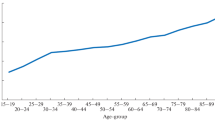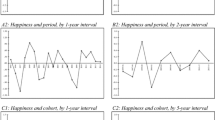Abstract
This study evaluated macro- and micro-level variables associated with individuals’ perception of the ending of youth, the beginning of old age, and the length of the middle age period. The European Social Survey is a biennial multi-country, cross-sectional survey. Our analysis is based on the fourth wave, which included a rotating module on ageism. The source sample consisted of 28 countries and a total of 54,988 respondents. Whereas macro-level variability accounted for 14 % of the variance associated with the perception of the ending of youth, only 5.7 % of the variance associated with the perception of the beginning of old age was accounted for by macro-level variability. Almost 10 % of the variance associated with the perception of the middle age period was associated with macro-level variability. Different patterns of macro- and micro-level correlates emerged for the ending of youth, beginning of old age, and the period of middle age. Overall, results demonstrate that individual differences in the perception of the ending of youth, the beginning of old age, and the length of the middle age period are more pronounced than contextual differences. Results also suggest that individuals’ mental maps regarding the timing of these events are not necessarily concordant.

Similar content being viewed by others
References
Abrams D, Lima L (2007) Experiences and expressions of ageism. http://www.europeansocialsurvey.org/index.php?option=com_content&task=view&id=219&Itemid=308. Accessed May 2013
Abrams D, Vauclair C-M, Swift H (2011) Predictors of attitudes to age in Europe. Research Report No. 735: Department for Work and Pensions. http://research.dwp.gov.uk/asd/asd5/rports2011-2012/rrep735.pdf. Accessed 12 Nov 2012
Andrew M, Eggerling-Boeck J, Sandefur GD, Smith B (2006) The “inner side” of the transition to adulthood: how young adults see the process of becoming an adult. Adv Life Course Res 11:225–251
Arnett JJ (2000) Emerging adulthood. A theory of development from the late teens through the twenties. Am Psychol 55(5):469–480
Atkinson AB (1970) On the measurement of inequality. J Econ Theory 2(3):244–263
Ayalon L, Covinsky KE (2009) Spouse-rated vs. self-rated health as predictors of mortality. Arch Intern Med 169(22):2156–2161
Barak B (2009) Age identity: a cross-cultural global approach. Int J Behav Dev 33(1):2–11
Barak B, Stern B (1986) Subjective age correlates: a research note. Gerontologist 26(5):571–578
Barrett AE (2003) Socioeconomic status and age identity: the role of dimensions of health in the subjective construction of age. J Gerontol B Psychol Sci Soc Sci 58B(2):S101–S109
Barrett AE (2005) Gendered experiences in midlife: implications for age identity. J Aging Stud 19(2):163–183
Barrett AE, von Rohr C (2008) Gendered perceptions of aging: an examination of college students. Int J Aging Hum Dev 67(4):359–386
Bart PB (1969) Why women’s status changes in middle age: the turns of the social ferris wheel. Sociol Symp 3:1–18
Baum SK, Boxley RL (1983) Age identification in the elderly. The Gerontologist 23(5):532–537
Benson JE, Furstenberg FF Jr (2006) Entry into adulthood: are adult role transitions meaningful markers of adult identity? Adv Life Course Res 11:199–224
Billari FC, Liefbroer AC (2010) Towards a new pattern of transition to adulthood? Adv Life Course Res 15(2–3):59–75
Borkan GA, Norris AH (1980) Assessment of biological age using a profile of physical parameters. J Gerontol 35(2):177–184
Bowling ANN, See-Tai S, Ebrahim S, Gabriel Z, Solanki P (2005) Attributes of age-identity. Ageing Soc 25(04):479–500
Brown R (1965) Social psychology. Free Press, New York
Buchmann M (1989) The script of life in modern society. Entry into adulthood in a changing world. University of Chicago Press, Chicago
Cameron P (1969) Age parameters of young adult, middle aged, old, and aged. J Gerontol 24(2):201–202
Central Intelligence Agency (2011) The world fact book. https://www.cia.gov/library/publications/the-world-factbook/rankorder/2119rank.html. Accessed May 2013
Clarke LH, Griffin M (2008) Visible and invisible ageing: beauty work as a response to ageism. Ageing Soc 28(05):653–674
Covey HC (1992) The definitions of the beginning of old age in history. Int J Aging Hum Dev 34(4):325–337
Crown WH (1985) Some thoughts on reformulating the dependency ratio. The Gerontologist 25(2):166–171
Cuddy AJC, Norton MI, Fiske ST (2005) This old stereotype: the pervasiveness and persistence of the elderly stereotype. J Soc Issues 61(2):267–285
Dannefer D, Daub A (2009) Extending the interrogation: life span, life course, and the constitution of human aging. Adv Life Course Res 14(1–2):15–27
Demongeot J (2009) Biological boundaries and biological age. Acta Biotheor 57(4):397–418
Denton FT, Spencer BG (2002) Some demographic consequences of revising the definition of “old age” to reflect future changes in life table probabilities. Can J Aging 21(3):349–356
Duncan C, Loretto W (2004) Never the right age? Gender and age-based discrimination in employment. Gend Work Organ 11(1):95–115
Esping-Andersen G (1990) The three worlds of welfare capitalism. Polity Press, Cambridge
Esping-Andersen G (1996) Welfare states in transition: national adaptations in global economy. SAGE, London
Esses VM, Dovidio JF, Jackson LM, Armstrong TL (2001) The immigration dilemma: the role of perceived group competition, ethnic prejudice, and national identity. J Soc Issues 57(3):389–412
Gilleard C (2009) Old age in the dark ages: the status of old age during the early Middle Ages. Ageing Soc 29(07):1065–1084
Grundy E, Henretta JC (2006) Between elderly parents and adult children: a new look at the intergenerational care provided by the “sandwich generation”. Ageing Soc 26(05):707–722
Hader S, Lynn P (2007) How representative can a multi-nation survey be? In: Jowell R, Roberts C, Fitzgerald R, Eva G (eds) Measuring attitudes cross-nationally: lessons from the European Social Survey. SAGE, London, pp 33–51
Hagestad GO, Uhlenberg P (2005) The social separation of old and young: a root of ageism. J Soc Issues 61(2):343–360
Hendricks J (2004) Public policies and old age identity. J Aging Stud 18(3):245–260
Hori S (1994) Beginning of old age in Japan and age norms in adulthood. Educ Gerontol 20(5):439–451
Hox J (2002) Multilevel analysis: techniques and application. Lawrence Erlbaum Associates, Mahwah, NJ
Hubley AM, Russell LB (2009) Prediction of subjective age, desired age, and age satisfaction in older adults: do some health dimensions contribute more than others? Int J Behav Dev 33(1):12–21
Johnson MK, Berg JA, Sirotzki T (2006) Relative age in the transition to adulthood. Adv Life Course Res 11:287–316
Karp DA (1988) A decade of reminders: changing age consciousness between fifty and sixty years old. The Gerontologist 28(6):727–738
Kaufman G, Elder GH (2002) Revisiting age identity: a research note. J Aging Stud 16(2):169–176
Kirk H (1992) Geriatric medicine and the categorisation of old age—the historical linkage. Ageing Soc 12(4):483–497
Kirkpatrick Johnson M, Allen Berg J, Sirotzki T (2007) Differentiation in self-perceived adulthood: extending the confluence model of subjective age identity. Soc Psychol Q 70(3):243–261
Kite ME, Stockdale GD, Whitley BE, Johnson BT (2005) Attitudes toward younger and older adults: an updated meta-analytic review. J Soc Issues 61(2):241–266
Kleinspehn-Ammerlahn A, Kotter-Grühn D, Smith J (2008) Self-perceptions of aging: do subjective age and satisfaction with aging change during old age? J Gerontol Ser B Psychol Sci Soc Sci 63(6):P377–P385
Kogan N (1979) A study of age categorization. J Gerontol 34(3):358–367
Kohli M (2007) The institutionalization of the life course: looking back to look ahead. Res Hum Dev 4(3):253–271
Kunst AE, Mackenbach JP (1994) The size of mortality differences associated with educational level in nine industrialized countries. Am J Public Health 84(6):932–937
Lachman M, Lewkowicz C, Marcus A, Peng Y (1994) Images of midlife development among young, middle-aged, and older adults. J Adult Dev 1(4):201–211
Levy BR, Zonderman AB, Slade MD, Ferrucci L (2009) Age stereotypes held earlier in life predict cardiovascular events in later life. Psychol Sci 20(3):296–298
Logan JR, Ward R, Spitze G (1992) As old as you feel: age identity in middle and later life. Soc Forces 71(2):451–467
Markides KS, Boldt JS (1983) Change in subjective age among the elderly: a longitudinal analysis. The Gerontologist 23(4):422–427
Martin SP (2004) Women’s education and family timing: outcomes and trends associated with age at marriage and first birth. In: Neckerman KM (ed) Social inequalities. Russell Sage Foundation, New York, pp 79–118
Mitnitski A, Graham J, Mogilner A, Rockwood K (2002) Frailty, fitness and late-life mortality in relation to chronological and biological age. BMC Geriatr 2(1):1
Nelson TD (2005) Ageism: prejudice against our feared future self. J Soc Issues 61(2):207–221
Neugarten BI, Hagestad GO (1976) Age and the life course. In: Binstock R, Shanas E (eds) Handbook of aging and the social sciences. Van Nostrand Reinhold, New York, pp 35–55
Neugarten BL, Moore JW, Lowe JC (1965) Age norms, age constraints, and adult socialization. Am J Sociol 70:710–717
Nikander P (2000) “Old” versus “little girl” a discursive approach to age categorization and morality. J Aging Stud 14(4):335–358
Nikander P (2009) Doing change and continuity: age identity and the micro-macro divide. Ageing Soc 29(special issue 06):863–881
Nydegger CN (1986) Age and life course transitions. In: Fry CL, Keith J (eds) New methods for old age research: strategies for studying diversity. Bergin and Garvey, South Hadley, MA, pp 131–161
Organization for Economic Co-operation and Development (2009) Statistics on average effective age and official age of retirement in OECD countries. http://www.oecd.org/document/47/0,3746,en_2649_33927_39371887_1_1_1_1,00.html. Accessed May 2013
Packer DJ, Chasteen AL (2006) Looking to the future: how possible aged selves influence prejudice toward older adults. Soc Cogn 24(3):218–247
Palmore E (2001) The ageism survey. The Gerontologist 41(5):572–575
Phelan A (2011) Socially constructing older people: examining discourses which can shape nurses’ understanding and practice. J Adv Nurs 67(4):893–903
Philip Morgan S (2003) Is low fertility a twenty-first-century demographic crisis? Demography 40(4):589–603
Preston SH (2007) The changing relation between mortality and level of economic development. Int J Epidemiol 36(3):484–490
Roebuck J (1979) When does old age begin? The evolution of the English definition. J Soc Hist 12(3):416–428
Sanderson W, Sergei S (2008) Rethinking age and aging. Popul Bull 63(4):1–20
Settersten RA (2003) Age structuring and the rhythm of the life course. In: Mortimer JT, Shanahan MJ (eds) Handbook of the life course. Springer, New York, pp 81–98
Smith T (2004) Coming of age in twenty-first century America: public attitudes towards the importance and timing of transitions to adulthood. Ageing Int 29(2):136–148
Tajfel H, Turner JC (1986) The social identity theory of intergroup behaviour. In: Worchel S, Austin WG (eds) Psychology of intergroup relations. Nelson-Hall, Chicago, pp 7–24
Taylor MG (2010) Capturing transitions and trajectories: the role of socioeconomic status in later life disability. J Gerontol Ser B Psychol Sci Soc Sci 65:733–743
Thorton A, Axinn WG, Teachman JD (1995) The influence of school enrollment and accumulation on cohabitation and marriage in early adulthood. Am Sociol Rev 60:762
Toothman EL, Barrett AE (2011) Mapping midlife: an examination of social factors shaping conceptions of the timing of middle age. Adv Life Course Res 16(3):99–111
Vincent JA (2008) The cultural construction old age as a biological phenomenon: science and anti-ageing technologies. J Aging Stud 22(4):331–339
Westerhof GJ, Barrett AE (2005) Age identity and subjective well-being: a comparison of the United States and Germany. J Gerontol Ser B Psychol Sci Soc Sci 60(3):S129–S136
Westerhof GJ, Whitbourne SK, Freeman GP (2012) The aging self in a cultural context: the relation of conceptions of aging to identity processes and self-esteem in the United States and the Netherlands. J Gerontol Ser B Psychol Sci Soc Sci 67B(1):52–60
Wiest M, Schuz B, Webster N, Wurm S (2011) Subjective well-being and mortality revisited: differential effects of cognitive and emotional facets of well-being on mortality. Health Psychol 30(6):728–735
World Health Organization (2010) World health statistics. http://www.who.int/whosis/whostat/en/. Accessed May 2013
World Health Organization (2011) Definition of an older or an elderly person. http://www.who.int/healthinfo/survey/ageingdefnolder/en/index.html. Accessed May 2013
Author information
Authors and Affiliations
Corresponding author
Additional information
Responsible Editor: H.-W. Wahl.
Rights and permissions
About this article
Cite this article
Ayalon, L., Doron, I., Bodner, E. et al. Macro- and micro-level predictors of age categorization: results from the European Social Survey. Eur J Ageing 11, 5–18 (2014). https://doi.org/10.1007/s10433-013-0282-8
Published:
Issue Date:
DOI: https://doi.org/10.1007/s10433-013-0282-8




